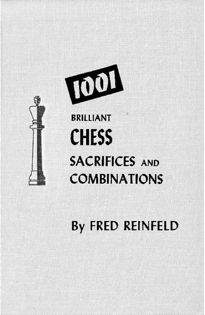1001 Winning Chess Sacrifices and Combinations
21st Century Edition
Fred Reinfeld

This review is actually about three books, which form a trilogy of eminently helpful resources to help chess players improve their games across the board!
Fred Reinfeld is said to be the most successful and prolific chess writer of all time, being associated with over one-hundred titles. His books on basic strategy, tactics, and overall chess wisdom were staples for chess players from the middle of the twentieth-century onward. Beginners and players of moderate standing digested his straightforward works and gained immense satisfaction from the improvements they experienced on the chessboard.
Now two of Reinfelds books have been issued in 21st Century Editions by Russell Enterprises. This has entailed editor Bruce Alberston converting all Reinfelds positions into algebraic notations, correcting some mistakes, and having all the diagrams set again. The results are attractive books which make two of Master Reinfelds classic studies available again for contemporary chess players.
These two books are companion volumes and together cover a full range of tactical chess issues. In Sacrifices and Combinations, the goal is to gain advantage and push toward victory, not necessarily to checkmate the King. In Checkmate, the diagrams are positions in which checkmate can be attained in a few moves. Sacrifices and Combinations features twenty chapters covering a full gamut of tactical weapons including, Pinning, Knight Forks, Discovered Attacks, Queening Combinations, Queen Sacrifices, Surprise Moves, Trapped Man, and The Helpless King. Each chapter features a few comments from Reinfeld about what to look for and the significance of each tactic. In introducing the book, Reinfeld wrote: The first step toward mastery is to become familiar with the different types of tactical motifs. The second step is to study a great many examples of these tactical themes. So, the object of this book is to add to your knowledge, to make you a strong chessplayer, and (last but not least) to delight you with some of the most beautiful moves ever played on the chessboard.
Reinfelds Checkmate features eight chapters with the positions all being forced checkmate positions, drawn primarily from actual play. So these are not simply contrived. The chapters are thematically organized: Queen Sacrifices, Checkmate Without the Queen, Storming the Castled Position, Harrying the King, Discovered Check and Double Check, Pawn Promotion, A Variety of Motifs, and Composed Problems. Again, Reinfeld introduces each chapter with perceptive comments.
Editor Alberston attests that these books (especially Checkmate) notably helped his game, a testimony that can be echoed by many others. Reinfeld promised that every chessplayer, no matter what his degree of skill may be, can learn how to play brilliant chess (Sacrifices and Combinations, 6). This unbounded optimism accompanied by Reinfelds skill in teaching and analysis makes his books of great ongoing value. Now future generations of players will continue to benefit from this brilliant writer.
The third book in this trio is an enlarged, second edition of a 2003 book by National Master Dan Heisman. 50% new material is added. The book is organized around meeting Threats, in three sections: Opening, Middlegame, and Endgame Threats. A helpful Glossary concludes the volume. Heisman says the intended reader of this book is rated between 1100 and 2300 USCF/FIDE, or between the upper level Beginner through Advanced tournament player (p. 16).
The chapters are set through a series of Problems. For each problem position, one is to identify the Threat and ways to stop the Threat, called Prevention. Each problem has a difficulty rating (stars) with the level of difficulty being set as the combined relative difficulty in finding the threat and the best prevention (p. 17).
In his Introduction, Heisman provides practical advice about meeting threats: There are three main things one can do about a threat: (1) Ignore it; (2) Create a bigger counter-threat (a counterattack); or (3) Stop it (p. 6). Five possible ways to meet a strong tactical threat: Capture, Move, Defend, Block, and Counterattack (p. 7).
The reader is to move through the Problems, identifying the Threat and Prevention. When both are done, the reader is instructed to read only the Threat answer. If the Threat is correctly identified, then the Prevention answer can be checked (p. 15). The goal is that after working through the more than 300 practical problems of varying degrees of difficulty and type, you will become much more adept at identifying threats and to meeting them. In describing the Threats and their Prevention, Heisman has written clearly and concisely. His positive Preventions are full enough discussions to give readers plain directions on what to anticipate and ways to respond.
These three reissued books are splendid resources to take players through tactical exercises that can certainly enhance their skills. The combined number of problems in these books and their solutions provide a deep reservoir of situations which will lead readers who work through them into being stronger players. These books put us under the tutelage of two splendid chess instructors. They are fine contributions to helping all players improve their chess talents.
